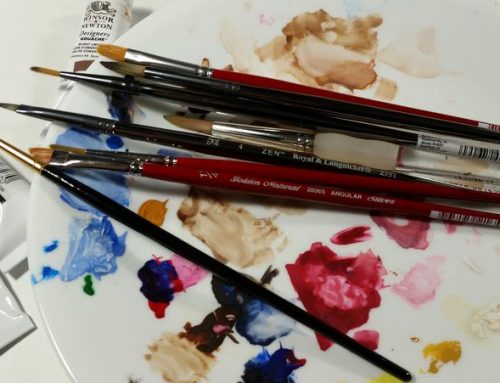A while back, in Paint Tests Done — I Choose…, I wrote about my decision to go with Atelier Interactive paints for my brushed acrylic needs. With many paintings under my belt with those paints, I had to make a decision whether to continue using them regardless of the investment I’d made to this point.
I’ve had two issues with Atelier Interactive, one small and one that just irks me. The small problem is one of the paint quality I receive. While about 75-80% of tubes are fine, most of the rest are thickened…some almost to the point of being irretrievable. They can be revived somewhat, but they are never really like that creamy, fresh-out-of-the-tube texture you’d like. But like I said, that wasn’t a deal breaker for me. No brand in my experience escapes either thickening or separating in some percentage of their tubes.
My biggest problem is with color shift — specifically with the appearance of a light bloom over any already-painted and recently dry areas that have titanium white in them. I suspect this is a side-effect of the rewetting feature that attracted me to the brand in the first place. While wet, the colors shift lighter by a considerable amount; this makes color matching/blending all but impossible. Yes, there are mediums to apply to either the canvas or the paint to set it so this doesn’t happen. Thing is, I don’t like having to essentially lay down an isolation coat for every painting session. It’s very irritating.
 As I mentioned in my previous article, my environment isn’t the friendliest for acrylic paints — even with wet palettes (which don’t quite do what I want them to do), retarding mediums, and misting with either spray bottles or airbrushes. A few months ago I tried a few sessions with my stash of regular Golden Heavy Body and Fluid acrylics just to see if my memory of them was wrong — and they were just as maddening as ever. Neither is an option in my studio except for special circumstances, although I will use High Flow acrylics with a dip pen if I need fine control of thin saturated lines. This again pretty much left only Golden Open Acrylics. Fortunately, I had just enough long-ago-purchased tubes on-hand (titanium white, ultramarine blue, pyrrole red, hanza yellow medium, and burnt sienna) to allow me to give it a chance on an in-progress painting. With these five colors, I could mix pretty much any hue I needed that wasn’t at the edge of gamut. Overall, they gave me a lot less grief. As far as the white bloom, there is none, which makes CJ a much happier painter.
As I mentioned in my previous article, my environment isn’t the friendliest for acrylic paints — even with wet palettes (which don’t quite do what I want them to do), retarding mediums, and misting with either spray bottles or airbrushes. A few months ago I tried a few sessions with my stash of regular Golden Heavy Body and Fluid acrylics just to see if my memory of them was wrong — and they were just as maddening as ever. Neither is an option in my studio except for special circumstances, although I will use High Flow acrylics with a dip pen if I need fine control of thin saturated lines. This again pretty much left only Golden Open Acrylics. Fortunately, I had just enough long-ago-purchased tubes on-hand (titanium white, ultramarine blue, pyrrole red, hanza yellow medium, and burnt sienna) to allow me to give it a chance on an in-progress painting. With these five colors, I could mix pretty much any hue I needed that wasn’t at the edge of gamut. Overall, they gave me a lot less grief. As far as the white bloom, there is none, which makes CJ a much happier painter.
I’ve done my last three paintings in the past several weeks using only Open Acrylics and have largely enjoyed it. While the paints still dry on my glass palette faster than I’d like despite misting with water every few minutes, it’s something I haven’t had much issue with since other traditional acrylics have been much worse. I may use up a little more paint than if I were at sea level or the tropics, but since I’m judicious with the size of the dollops I put on my board, the waste isn’t that much. It also helps that the paints are more generally available here in the states than Atelier.
What of my stockpile of Atelier tubes? I’ll toss the ones that have thickened and the rest will be dedicated to painting 3d prints and models. They work fine for that and it relieves me of the guilt of using artist paints on something other that “real art”.
So yeah. Even though Atelier showed a lot of promise for the work I do, and are in general very good artist-quality paints, in the end I had to go with the brand I know best. Wish I’d learned it before I built up the ol’ paint larder, but other than shelling out some ducats, no harm was done. Because there really aren’t any other options I know of that will allow me to work as I want — and since I’ve been a more-or-less Golden brand loyalist for more years than I’m willing to disclose (<cough>a lot<cough>) — so long as they don’t mung up the formula, I expect I’ll be using and praising Open Acrylics for my hairy-stick artist-level acrylic needs for the foreseeable future.





